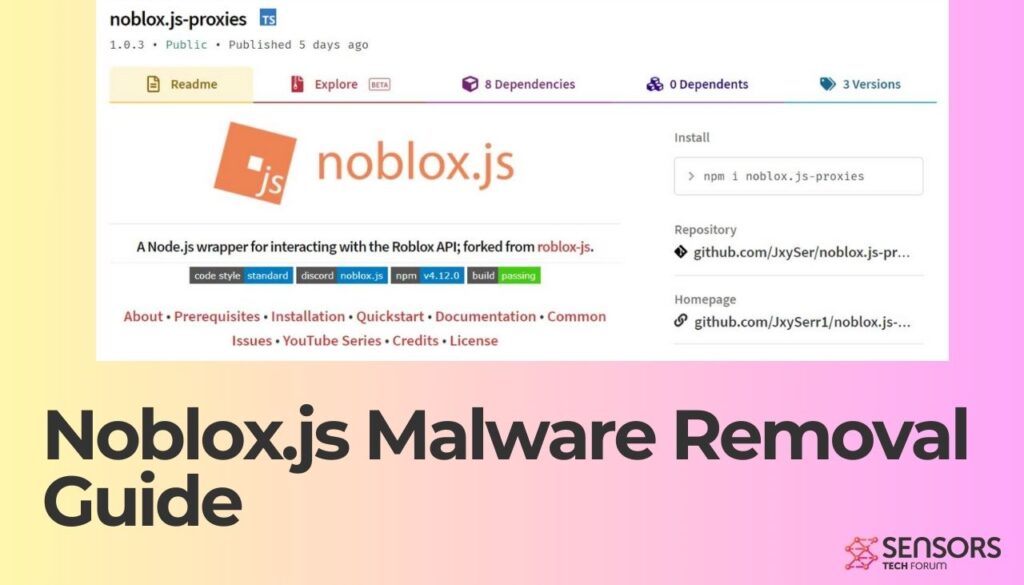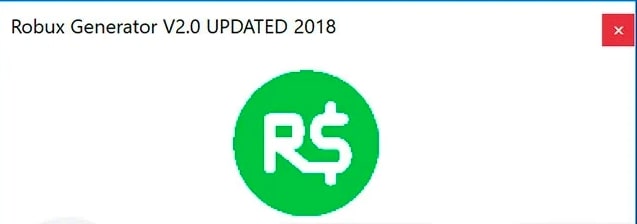What Is Noblox.js?
A dangerous software package called “noblox.js-rpc” (or for short noblox.js) has been reported on the npm registry, an online database and repository where developers can publish, share, and manage JavaScript packages (modules or libraries) used with Node.js. Due to the origin of the attack, some people refer to this type of malware as “NPM malware”.
The dangerous noblox.js package uses familiar methods to steal sensitive information, including login details, important files, and even the Windows registration key. After gathering this data, it can install ransomware on your system. This makes noblox.js-rpc a very dangerous piece of malware that should be removed immediately from the infected system.

Noblox.js Summary
| Name | Noblox.js |
| Type | Infection for Ransomware or Trojan |
| Short Description | Infects your computer and then installs a fraudulent hacktool or patch on your computer to get ransomware to encrypt its files so that you can pay ransom to recover them. |
| Symptoms | Files have been encrypted and cannot be opened and you must pay ransom so that you can recover them and get them to work. |
| Ransom Demanding Note | _readme.txt |
| Distribution Method | Discord, Malicious Software Packages |
| Detection Tool |
See If Your System Has Been Affected by malware or other threats. Download
Malware Removal Tool
|
Noblox.js – How Did I Get It?
The malicious package is likely distributed through software cracks of the Roblox game, as well as on the Discord channel of the game.
Given the nature of these packages, it’s clear that the attackers are targeting Roblox game users. But how do they trick these users into installing and running a rogue npm package? This Discord server likely serves as a platform where attackers lure Roblox players, convincing them to install the malicious package under the guise of offering game-related enhancements or services.
Cracks are one very effective method to spread viruses, like this one. This is because many users nowadays know how to crack a game and play it without paying. But the real risk comes from the crack itself. During the course of our investigation on this particular malware, we have managed to find out that there are several hacktools of the game that are out there.
One of them carries the name Robux Generator v2.0 and appears like the following:

This particular activator mainly sets various different types of files after you download and run it. It may also have the so-called obfuscator, also known as “cryptor” in the trade, which hides the infection from your own antivirus program. This is why it is recommended to always keep an anti-malware software with good real-time protection on.
Another infection with this particular malware is called Roblox Hack Generator, and it looks like the following:

Malicious Activities of Noblox.js
The malicious package “noblox.js-rpc” is triggered by a postinstall script in its package.json file. A single command, node postinstall.js, initiates the attack. This script is deliberately obfuscated, making it hard to understand, but it specifically targets Windows machines by checking the operating system before proceeding.
The script creates and runs a setup.bat file, which is also obfuscated. This batch script is crucial as it downloads and runs additional malicious files. These files include Rar.bat, Rar.exe, Rara.exe, and Mbr.exe. The first step of the attack is to disable Windows Defender by adding a broad exclusion rule, thus making sure that the malware can run unchecked. Then, the script begins stealing data using Rar.exe and Rara.exe.
Rar.exe, a custom-made stealer, attempts to collect session files from Minecraft and cookies from Roblox, targeting users who likely play these games. To ensure no data is missed, Rara.exe follows up, stealing all credentials it can find. In the last stage of the attack, the malware deploys ransomware with Mbr.exe, which overwrites the Master Boot Record, rendering the machine unbootable and displaying a ransom note.
It is noteworthy that, while the files themselves aren’t encrypted, the machine becomes unusable, and the attacker demands a ransom through a Discord server, holding the victim’s sensitive data hostage.
Remove Noblox.js Malware
This malware can be deleted from your machine, if you follow the removal guide below this article. It has the necessary steps to help isolate and eliminate this threat. It is recommended to download and run an advanced anti-malware program that will detect any objects of the Noblox.js malware.
Preparation before removing Noblox.js.
Before starting the actual removal process, we recommend that you do the following preparation steps.
- Make sure you have these instructions always open and in front of your eyes.
- Do a backup of all of your files, even if they could be damaged. You should back up your data with a cloud backup solution and insure your files against any type of loss, even from the most severe threats.
- Be patient as this could take a while.
- Scan for Malware
- Fix Registries
- Remove Virus Files
Step 1: Scan for Noblox.js with SpyHunter Anti-Malware Tool



Step 2: Clean any registries, created by Noblox.js on your computer.
The usually targeted registries of Windows machines are the following:
- HKEY_LOCAL_MACHINE\Software\Microsoft\Windows\CurrentVersion\Run
- HKEY_CURRENT_USER\Software\Microsoft\Windows\CurrentVersion\Run
- HKEY_LOCAL_MACHINE\Software\Microsoft\Windows\CurrentVersion\RunOnce
- HKEY_CURRENT_USER\Software\Microsoft\Windows\CurrentVersion\RunOnce
You can access them by opening the Windows registry editor and deleting any values, created by Noblox.js there. This can happen by following the steps underneath:


 Tip: To find a virus-created value, you can right-click on it and click "Modify" to see which file it is set to run. If this is the virus file location, remove the value.
Tip: To find a virus-created value, you can right-click on it and click "Modify" to see which file it is set to run. If this is the virus file location, remove the value.Step 3: Find virus files created by Noblox.js on your PC.
1.For Windows 8, 8.1 and 10.
For Newer Windows Operating Systems
1: On your keyboard press + R and write explorer.exe in the Run text box and then click on the Ok button.

2: Click on your PC from the quick access bar. This is usually an icon with a monitor and its name is either “My Computer”, “My PC” or “This PC” or whatever you have named it.

3: Navigate to the search box in the top-right of your PC's screen and type “fileextension:” and after which type the file extension. If you are looking for malicious executables, an example may be "fileextension:exe". After doing that, leave a space and type the file name you believe the malware has created. Here is how it may appear if your file has been found:

N.B. We recommend to wait for the green loading bar in the navigation box to fill up in case the PC is looking for the file and hasn't found it yet.
2.For Windows XP, Vista, and 7.
For Older Windows Operating Systems
In older Windows OS's the conventional approach should be the effective one:
1: Click on the Start Menu icon (usually on your bottom-left) and then choose the Search preference.

2: After the search window appears, choose More Advanced Options from the search assistant box. Another way is by clicking on All Files and Folders.

3: After that type the name of the file you are looking for and click on the Search button. This might take some time after which results will appear. If you have found the malicious file, you may copy or open its location by right-clicking on it.
Now you should be able to discover any file on Windows as long as it is on your hard drive and is not concealed via special software.
Noblox.js FAQ
What Does Noblox.js Trojan Do?
The Noblox.js Trojan is a malicious computer program designed to disrupt, damage, or gain unauthorized access to a computer system.
It can be used to steal sensitive data, gain control over a system, or launch other malicious activities.
Can Trojans Steal Passwords?
Yes, Trojans, like Noblox.js, can steal passwords. These malicious programs are designed to gain access to a user's computer, spy on victims and steal sensitive information such as banking details and passwords.
Can Noblox.js Trojan Hide Itself?
Yes, it can. A Trojan can use various techniques to mask itself, including rootkits, encryption, and obfuscation, to hide from security scanners and evade detection.
Can a Trojan be Removed by Factory Reset?
Yes, a Trojan can be removed by factory resetting your device. This is because it will restore the device to its original state, eliminating any malicious software that may have been installed. Bear in mind, that there are more sophisticated Trojans, that leave backdoors and reinfect even after factory reset.
Can Noblox.js Trojan Infect WiFi?
Yes, it is possible for a Trojan to infect WiFi networks. When a user connects to the infected network, the Trojan can spread to other connected devices and can access sensitive information on the network.
Can Trojans Be Deleted?
Yes, Trojans can be deleted. This is typically done by running a powerful anti-virus or anti-malware program that is designed to detect and remove malicious files. In some cases, manual deletion of the Trojan may also be necessary.
Can Trojans Steal Files?
Yes, Trojans can steal files if they are installed on a computer. This is done by allowing the malware author or user to gain access to the computer and then steal the files stored on it.
Which Anti-Malware Can Remove Trojans?
Anti-malware programs such as SpyHunter are capable of scanning for and removing Trojans from your computer. It is important to keep your anti-malware up to date and regularly scan your system for any malicious software.
Can Trojans Infect USB?
Yes, Trojans can infect USB devices. USB Trojans typically spread through malicious files downloaded from the internet or shared via email, allowing the hacker to gain access to a user's confidential data.
About the Noblox.js Research
The content we publish on SensorsTechForum.com, this Noblox.js how-to removal guide included, is the outcome of extensive research, hard work and our team’s devotion to help you remove the specific trojan problem.
How did we conduct the research on Noblox.js?
Please note that our research is based on an independent investigation. We are in contact with independent security researchers, thanks to which we receive daily updates on the latest malware definitions, including the various types of trojans (backdoor, downloader, infostealer, ransom, etc.)
Furthermore, the research behind the Noblox.js threat is backed with VirusTotal.
To better understand the threat posed by trojans, please refer to the following articles which provide knowledgeable details.













